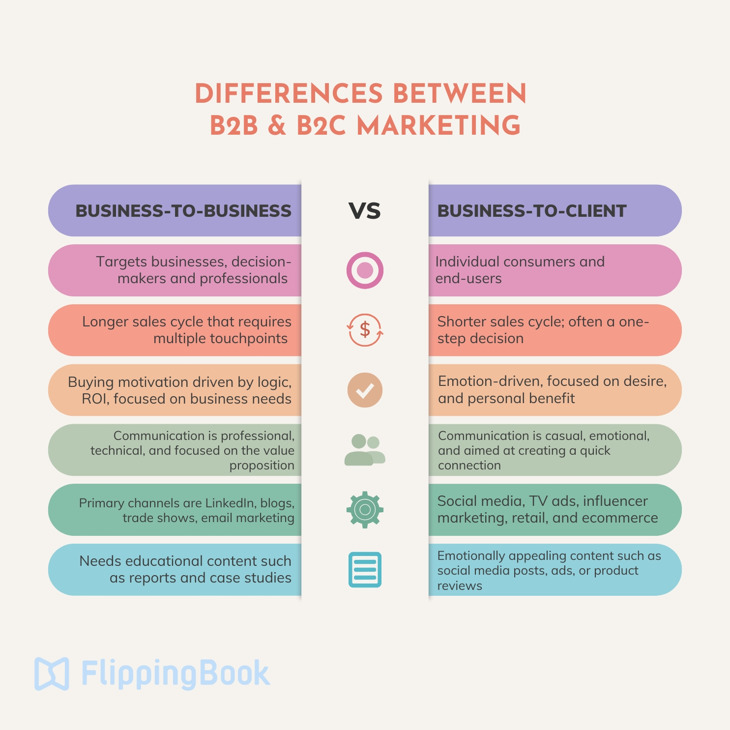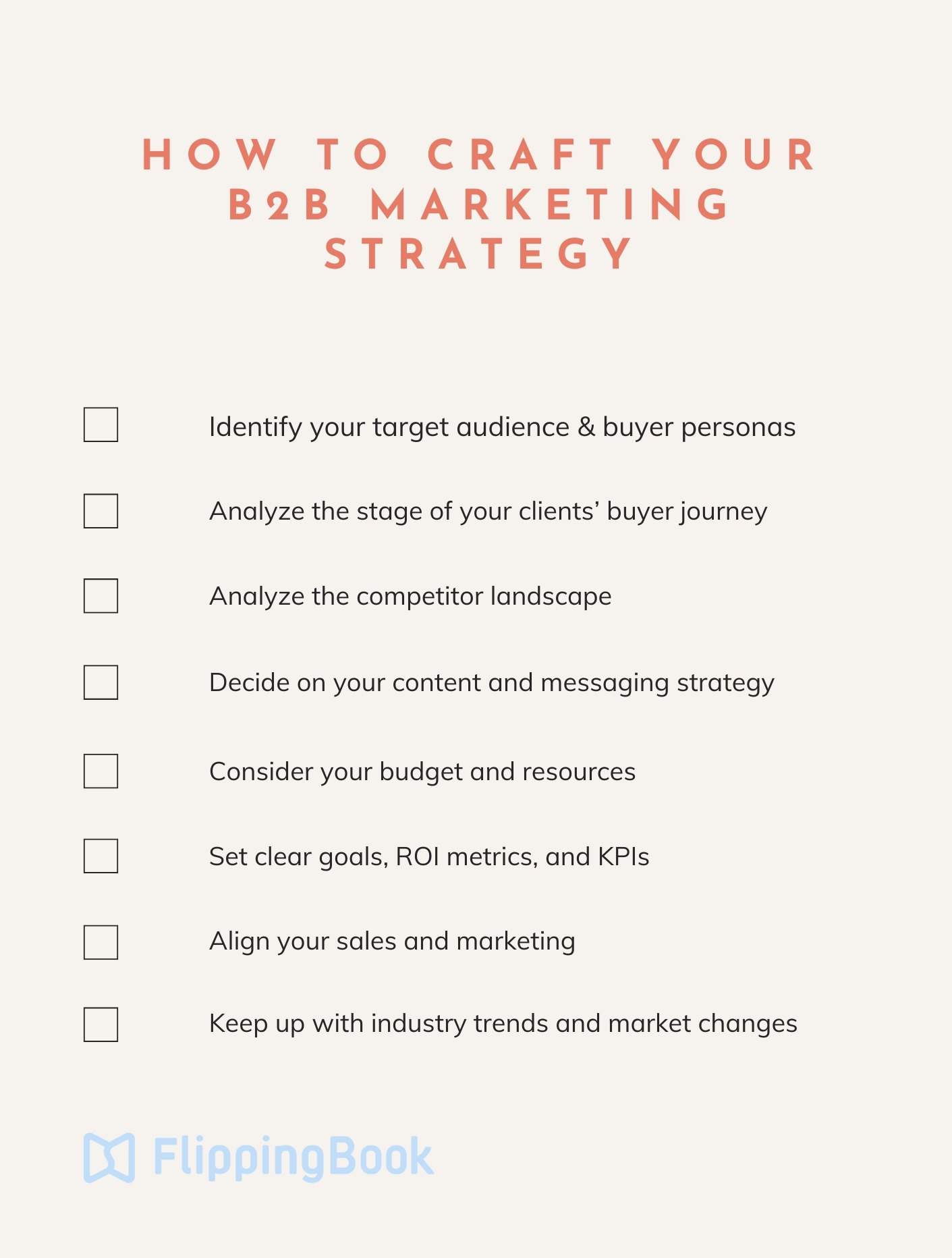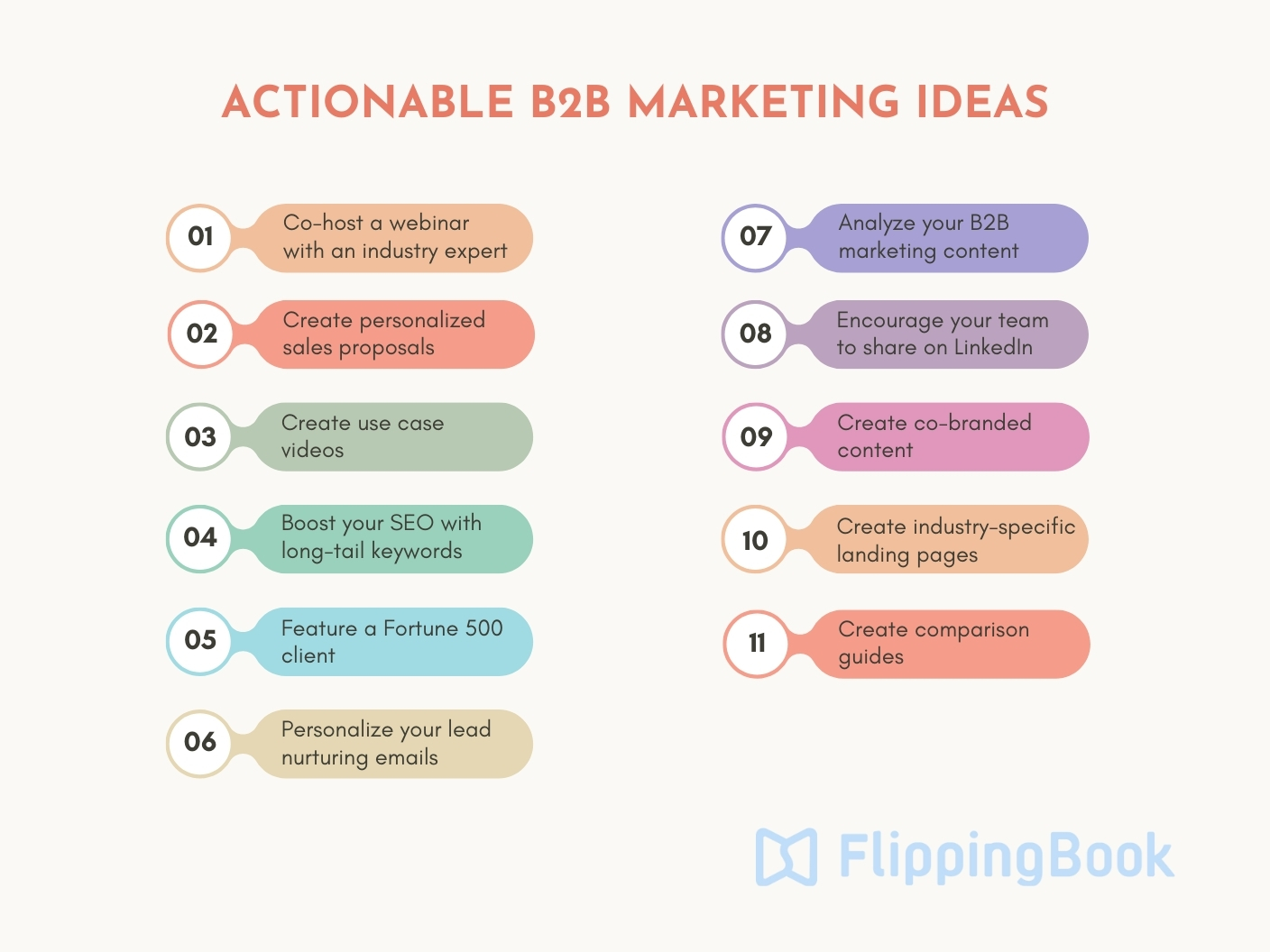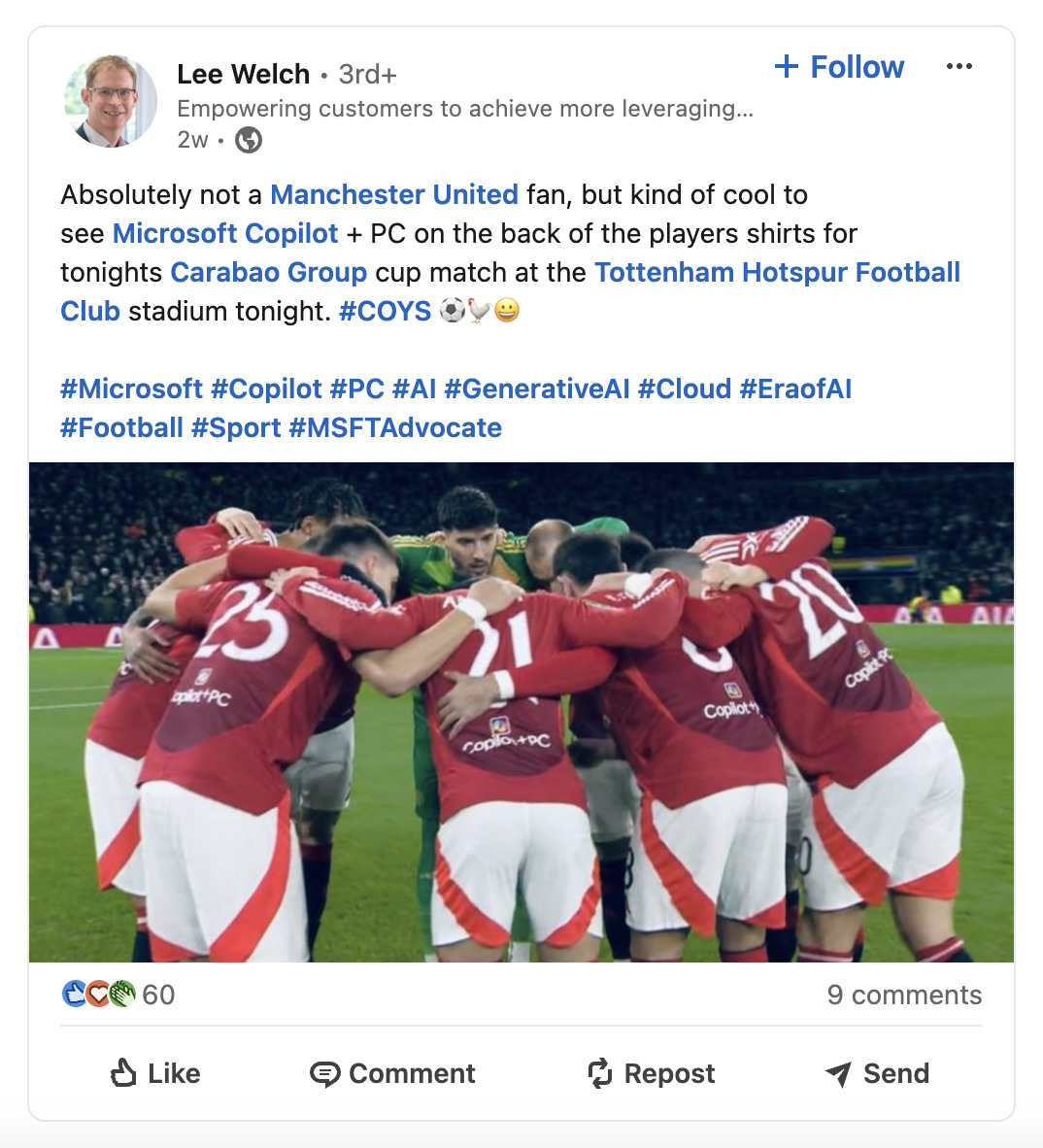Both B2B and B2C marketing present challenges when striving for high, repeatable results and trying to stay ahead of the competition.
That said, B2C marketing feels more familiar. We encounter it daily—on social media, in our inboxes, on billboards, and on YouTube. Many marketing guides also lean heavily toward B2C, offering suggestions like running social media contests or creating short-form videos to engage audiences on platforms like TikTok.
B2B marketing, on the other hand, can sometimes appear more limited or even outdated. (Sending postcards via direct mail? Seriously?) But that’s a misconception.
Let's explore what a B2B marketing strategy really entails, how it differs from B2C, and how to choose the right approach for your business. We’ll also share some actionable B2B marketing ideas to help you build a great marketing plan—whether you're a new business owner or an experienced B2B marketer in need of fresh inspiration.
What Is a B2B Marketing Strategy?
A B2B (business-to-business) marketing strategy focuses on promoting products or services to other companies rather than individual consumers. The goal is to attract, engage, and convert businesses into clients or partners.
Typically, B2B marketing targets professionals within organizations who are searching for complex solutions or products to support their business operations. The sales cycle tends to be longer, with decision-making processes often involving multiple stakeholders and structured steps. In contrast with consumers, clients are seen as long-term partners, so building strong, enduring relationships is key to retaining business over the years.
B2B Marketing vs. B2C Marketing

While the primary objectives of both B2B and B2C marketing—attracting new customers and making sales—are similar, the buyer personas, sales cycles, marketing channels, and content are quite different.
However, that doesn’t mean an individual consumer can’t be swayed by logic, or that a professional purchasing on behalf of a company won’t be moved by emotions when they encounter something impressive. After all, even when marketing to businesses, we’re still communicating with people.
The question is: how do you combine the best of both worlds to create a strategy that resonates with your specific audience and drives more sales?
How to Craft an Effective B2B Marketing Strategy?

There are more creative marketing ideas out there than you could possibly try. Luckily, you don’t need to do that, you only need to analyze your business needs, resources, and limits to select a few most fitting methods. Here are some things to consider when planning your B2B marketing strategy:
🎯 Identify your target audience
Understanding your audience is crucial for tailoring your messaging, content, and marketing activities. Start by studying your existing clients and envisioning your ideal customer. Consider the following questions:
- Who are the decision-makers in your target companies?
- What is their business role?
- What size and type of companies are you targeting?
- What are your potential clients’ pain points and challenges?
You can gather insights by interviewing current clients or networking with your target audience at industry events and trade shows.
📈Analyze your clients’ buyer’s journey
The buyer’s journey represents the steps your customer takes toward making a purchase. Typically, this journey includes three stages:
- Awareness: The client becomes aware of a problem or challenge.
- Consideration: The client actively explores solutions.
- Decision: The client decides on a solution and evaluates providers.
To create an effective B2B marketing strategy, understand where your potential clients are in this journey and provide them with relevant touchpoints (meaningful iterations)—whether through social media, email newsletters, or direct sales—to help guide them toward making a purchase.
🕵️ Analyze the competitor landscape
Studying your competitors can provide valuable insights. You’ll learn about their target audience, common strategies, and messaging. Understanding their strengths and weaknesses can reveal opportunities for you to stand out, and you may discover useful tactics along the way.
📣 Decide on your content strategy
Depending on where your clients are in the buyer's journey, they’ll require different types of content—whether it’s blog posts, case studies, white papers, or webinars.
However, messaging is even more important than the format. Craft messages that resonate with your audience and address their specific pain points. If your messaging strikes a chord, your content will not only engage but also educate and convert.
💸 Consider your budget and resources
No business has endless money to spend on marketing efforts, so for your marketing strategy to work out, you will need to understand both constraints and possibilities.
To ensure your strategy is effective, consider your financial constraints and available resources, such as your team size, marketing tools, and time frames. Understanding these limits will help you prioritize activities and set realistic goals.
Speaking about goals…
📊 Measure ROI and KPIs
The only way to gauge the success of your marketing strategy is to set clear metrics. Common examples include lead conversion rates or customer acquisition costs.
Your KPIs will vary depending on your goals, but they could include metrics like the number of white paper downloads, webinar registrations, or social media reach.
🤝 Align your sales and marketing
Ensure that your sales and marketing teams are aligned with a clear process for handing off qualified leads. This reduces communication gaps and prevents missed opportunities.
You can foster collaboration by setting shared objectives, involving sales reps in content creation, and using a unified CRM to track and manage leads across both teams.
🚀 Stay ahead of industry trends
The pandemic and the rise of AI have shown us how quickly the business landscape can shift. Staying up-to-date on industry trends is essential for adapting your strategy. Here are some ways to keep up:
- Subscribe to industry newsletters and blogs.
- Join LinkedIn groups and industry-specific forums.
- Invest in market research from trusted sources like Gartner or Forrester.
- Use social media monitoring tools like Hootsuite or Brandwatch to stay informed.
An Overview of B2B Marketing Strategies
B2B marketing strategies typically fall into several major categories. No matter which direction you take, your activities will likely align with one of these approaches. So let’s review them before diving into more specific, actionable marketing ideas.
#1 Account-based marketing (ABM)
Account-based marketing focuses on identifying high-value accounts within your industry and crafting a personalized buyer experience for them. The key benefits of this strategy include increased ROI and the development of deeper relationships that can lead to more opportunities thanks to word-of-mouth.
ABM requires close collaboration between sales and marketing. One way to strengthen this alignment is by creating sales enablement materials, such as personalized, interactive sales proposals tailored to specific accounts.
#2 Content marketing
Content still reigns supreme when it comes to B2B marketing. B2B clients are typically driven by logic and clear, measurable benefits, so educational content plays a pivotal role.
Focus your efforts on blog posts, webinars, ebooks, white papers, and case studies—74% of marketers say these formats are crucial for demonstrating real-world value and persuading the client during the consideration stage of their customer journey. These materials can also serve as lead magnets, helping you attract high-quality leads.
Additionally, educational content adds value during the awareness stage, when potential clients are just beginning to recognize their challenges. With strong SEO, they can discover your content, learn about their problem, and explore available solutions, yours included.
Looking to elevate your marketing materials?
FlippingBook lets you convert any static PDF into an interactive document. Share your materials as links, enhance them with videos and GIFs, and track user interactions with your content.
#3 Email marketing
Like content, email marketing is a cornerstone of the B2B strategy. Personalized email campaigns allow you to target specific audiences, tailoring your messaging to their needs and pain points. Emails can be effective throughout the buyer’s journey and are especially useful for nurturing leads at any stage of the funnel.
#4 Social media campaigns
Social media remains a powerful tool for B2B lead generation and engagement. Focus on platforms like LinkedIn, YouTube, and X (formerly Twitter), where professionals network and share insights. Encourage your employees to be active on these platforms to expand your reach even further.
#5 Video marketing and webinars
B2B marketing thrives on building relationships, and video formats like product demos, explainer videos, live webinars, and short-form videos provide a great way to connect with your audience. Videos allow you to engage prospects directly, answer their questions, and demonstrate how your product works. This not only builds credibility but also helps clarify complex ideas and address objections, moving prospects further down the funnel.
#6 Paid advertising (PPC & LinkedIn Ads)
Paid advertising, such as PPC (Pay-Per-Click) campaigns, is one of the most direct strategies, with easily measurable ROI. Success hinges on precise targeting, so conducting thorough keyword research to identify high-intent keywords is crucial.
While Google Ads is a go-to platform, LinkedIn Ads can also be highly effective for B2B, offering superior targeting capabilities. However, because users spend less time on LinkedIn, your ads must be highly compelling, and your messaging should be constantly refined to improve performance.
#7 Customer retention
In B2B, with high acquisition costs and long sales cycles, retaining existing customers is critical. A solid customer retention strategy might include developing a loyalty program that rewards clients with premium services. Additionally, implementing feedback mechanisms like satisfaction surveys and NPS can help you understand what your customers value most and identify areas for improvement, enhancing long-term satisfaction.
If you want to collect feedback in a friendly, unobtrusive way, try embedding a survey into your brochures or ebooks. Your clients will get a more interactive experience, and you will get valuable insights.
#8 Thought leadership
Positioning your brand as an industry authority enhances your credibility, raises brand awareness, and can significantly shorten your sales cycle by reducing objections from leads. You can establish thought leadership by conducting industry research, publishing reports and white papers, and participating in or hosting industry events and conferences. Although this approach demands time and resources, it’s a worthwhile investment that brings long-term benefits.
💡 Actionable B2B Marketing Ideas
Now that we have covered the basics, let’s talk about concrete ideas you can try to attract clients and drive more sales.

#1 Co-host a webinar with an industry expert
This idea sits at the intersection of video marketing and thought leadership. Hosting a live webinar with an industry expert helps raise brand awareness, generate leads, and establish your authority in the field. It’s also an excellent platform for discussing industry challenges and trends while demonstrating how your product fits in—without being too salesy.
Choose a reliable webinar platform that your audience is familiar with, and ensure it offers interaction features like live polls and chat to keep the engagement high.
#2 Engage better with personalized sales proposals
Even small efforts in personalization can go a long way in winning high-stakes accounts. And it’s not as time-consuming as you might think. All you need is a few baseline documents that you can brand to match your client’s style, and add a personalized video greeting for that extra touch.
For an even more elevated look that will make your clients feel valued, you can turn your PDFs into interactive proposals in the flipbook format.
Flipbooks support all kinds of interactive content—videos, GIFs, and pop-ups—making your proposals more engaging and memorable.
Plus, you can easily share them via a link and track user engagement in real time thanks to built-in analytics.
#3 Create use case videos
Instead of creating generic video tutorials, focus on short, engaging videos that highlight how your product solves specific tasks. These are more relatable to your audience, as they address real-world challenges. Videos have proven to be more engaging than text or audio, which makes them a powerful tool to communicate value effectively. For inspiration, here’s how we’ve done it at FlippingBook:
Video production does require time and resources, but advances in AI have made it more affordable, so even with a small team and budget, this is a worthwhile investment.
#4 Boost your SEO with long-tail keywords
Long-tail keywords are more specific, niche search phrases that target higher-intent queries. For example:
- Short-tail keyword: Email marketing platform
- Long-tail keyword: Affordable email marketing platform for small businesses
While long-tail keywords have lower search volumes, they attract more qualified leads who are closer to making a purchase decision. This makes niche-specific keywords a great addition to your SEO strategy, helping you rank higher and convert better.
#5 Publish a case study with a Fortune 500 client
Case studies are always valuable, but highlighting work with a well-known brand lends extra credibility and gives your story more weight. Plus, the study can be repurposed for various uses—whether as a sales tool, a part of your onboarding process, or as a promotional piece on social media.
#6 Personalize your lead nurturing emails
To make your email marketing more effective, consider not just demographic data but also where the lead is in the sales funnel. This way, you can tailor your content accordingly. For example, someone at the consideration stage may take an interest in case studies and webinars, while a lucrative offer may entice a person ready to make a purchase.
You can segment leads using sign-up questions, lead enrichment tools, and by tracking user behavior on your website.
#7 Analyze your B2B marketing content for deeper insights
White papers, case studies, brochures, and ebooks are an integral part of almost every B2B marketing strategy. But how can you ensure that your content is delivering the desired ROI? Beyond just counting downloads, you can dig deeper into how leads interact with your content by turning PDFs into interactive flipbooks.
Flipbooks offer detailed analytics—visitor engagement, reading time, clicks, and more—allowing you to fine-tune your content. Here’s a quick overview:
You’ll also be able to qualify leads more accurately based on how deeply they are engaged with the materials. To achieve this, tools like FlippingBook let you track individual lead engagement.
#8 Encourage your team to share content on LinkedIn
LinkedIn is a powerful platform for B2B marketing, where quality content can quickly gain traction.
To maximize exposure, encourage your employees to share marketing content. In fact, employees can be outstanding brand ambassadors on LinkedIn and on other social media platforms. They can offer thoughtful insights, start meaningful conversations, and are often seen as more authentic than a hired influencer. Also, you can check out other LinkedIn marketing strategies to unlock its full potential for your business growth.
Here's a fantastic example by Microsoft employee Lee Wench. His content is professional and engaging at the same time, showing off his personality and helping the brand to reach the wast community it wouldn't be able to engage otherwise.

Source: Lee Welch on LinkedIn
#9 Create co-branded content for cross-promotion
Collaborating with another brand to produce high-value content and then cross-pollinating your audiences is a great way for both parties to acquire qualified leads. Collaboration formats can include:
- Research reports
- White papers
- Ebooks on industry-specific topics
- Podcasts
- Guest blog-posts
- Joint social media campaigns
You can also consider offering a bundled product if promoting to a new audience—this makes the collaboration even more impactful.
#10 Create industry-specific landing pages
If your product serves multiple industries, creating search-optimized, industry-specific landing pages is a great way to address each audience's unique needs. These pages allow you to showcase relevant case studies, client reviews, and feature highlights all in one place, making a compelling case for your product. Plus, of course, you can expand your outreach by using industry-specific long-tail keywords, as discussed above.
On the flip side, designing, publishing, and maintaining a landing page can be quite a lot of work. Luckily, there are website alternatives you can use for faster, more cost-effective results.
#11 Influence buyer decisions with comparison guides
Ask any sales rep how often they hear: “How are you different from your competitors?” from a lead. Most likely, they'll reply with a heavy sigh.
The best way to enable them is to create comparison guides that clearly show how you stand against your competition, highlight key features and benefits, and address common objectives. Make sure to use visual infographics, tablets, and charts to break down difficult concepts and simplify the decision-making process for your leads.
Strive to be objective and transparent. No one is perfect, and your competitors are bound to have strengths. Don’t be afraid to acknowledge them while emphasizing the advantages of your solution. This will turn your guide into a helpful resource, not a promotional piece.
Final Thoughts
A well-executed B2B marketing strategy can deliver measurable results, from higher conversions to increased sales. Plus, it’s an opportunity to experiment, create, and engage with a variety of audiences. We hope these actionable ideas provide a solid starting point for your next marketing campaign. Remember to stay true to your brand and focus on genuinely helping your audience while promoting your business. Good luck!





